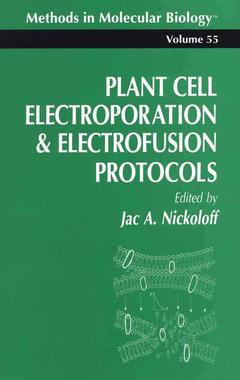Description
Plant Cell Electroporation And Electrofusion Protocols, 1995
Methods in Molecular Biology Series, Vol. 55
Coordinator: Nickoloff Jac A.
Language: English
Subject for Plant Cell Electroporation And Electrofusion Protocols:
Publication date: 08-2013
206 p. · 17x24.4 cm · Paperback
206 p. · 17x24.4 cm · Paperback
Description
/li>Contents
/li>
Gene transfer is an essential technology for improving our under standing of gene structure and function. Although there are many meth ods by which DNA may be introduced into cells?including heat and chemical treatments, and microinjection?electroporation has been found to be the most versatile gene transfer technique. Electroporation is effective with a wide variety of cell types, including those that are difficult to transform by other means. For many cell types, electroporation is either the most efficient or the only means known to effect gene transfer. The early and broad success of electric field-medi ated DNA transfer soon prompted researchers to investigate electroporation for transferring other types of molecules into cells, in cluding RNA, enzymes, antibodies, and analytic dyes. The first section of Plant Cell Electroporation and Electrofusion Protocols includes two chapters that serve as a guide to theoretical and practical aspects of electroporation, and will be of particular interest to those developing protocols for as yet untested species or cell types, and a third chapter that describes commercially available electroporation instruments. The remaining chapters describe well-tested protocols for DNA electrotransfection, electroporation of other biomolecules, or cell electrofusion. These chapters also include brief discussions of alterna tives to electric field-based methods, citing the advantages and limita tions of the various methods for achieving specific goals.
Part I. Theory And Instrumentation. Electroporation Theory: Concepts and Mechanisms. Effects of Pulse Length and Strength on Electroporation Efficiency. Instrumentation. Part II. Electroporation Protocols. Electroporation of Agrobacterium tumefaciens. Electroporation of DNA into the Unicellular Green Alga Chlamydomonas reinhardtii. Pollen Electrotransformation in Tobacco. Electroporation of Tobacco Leaf Protoplasts Using Plasmid DNA or Total Genomic DNA. Electroporation of Brassica. Transformation of Maize by Electroporation of Embryos. Transient Gene Expression Analysis in Electroporated Maize Protoplasts. Reporter Genes and Transient Assays for Plants. Part III. Electrofusion Protocols. Electrofusion of Plant Protoplasts: Selection and Screening for Somatic Hybrids of Nicotiana. Protoplast Electrofusion and Regeneration in Potato. Polymer-Supported Electrofusion of Protoplasts: A Novel Method and a Synergistic Effect. Index.
© 2024 LAVOISIER S.A.S.




